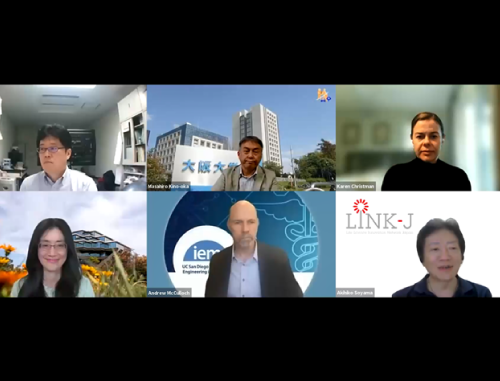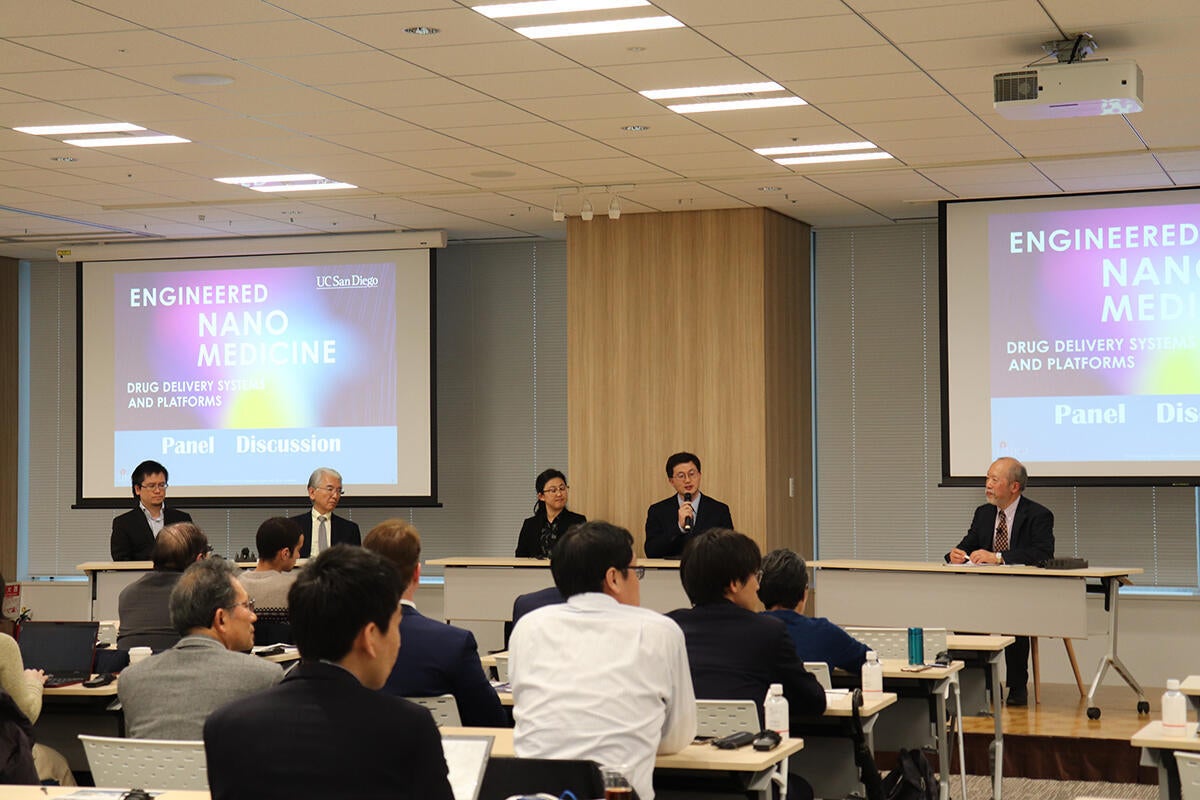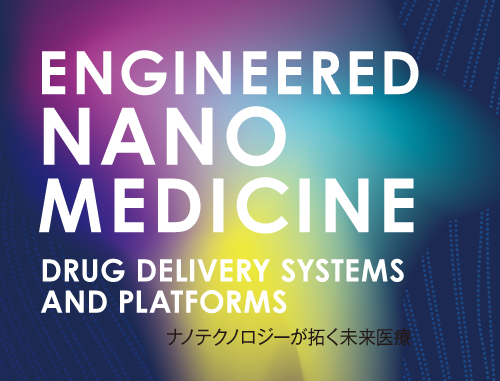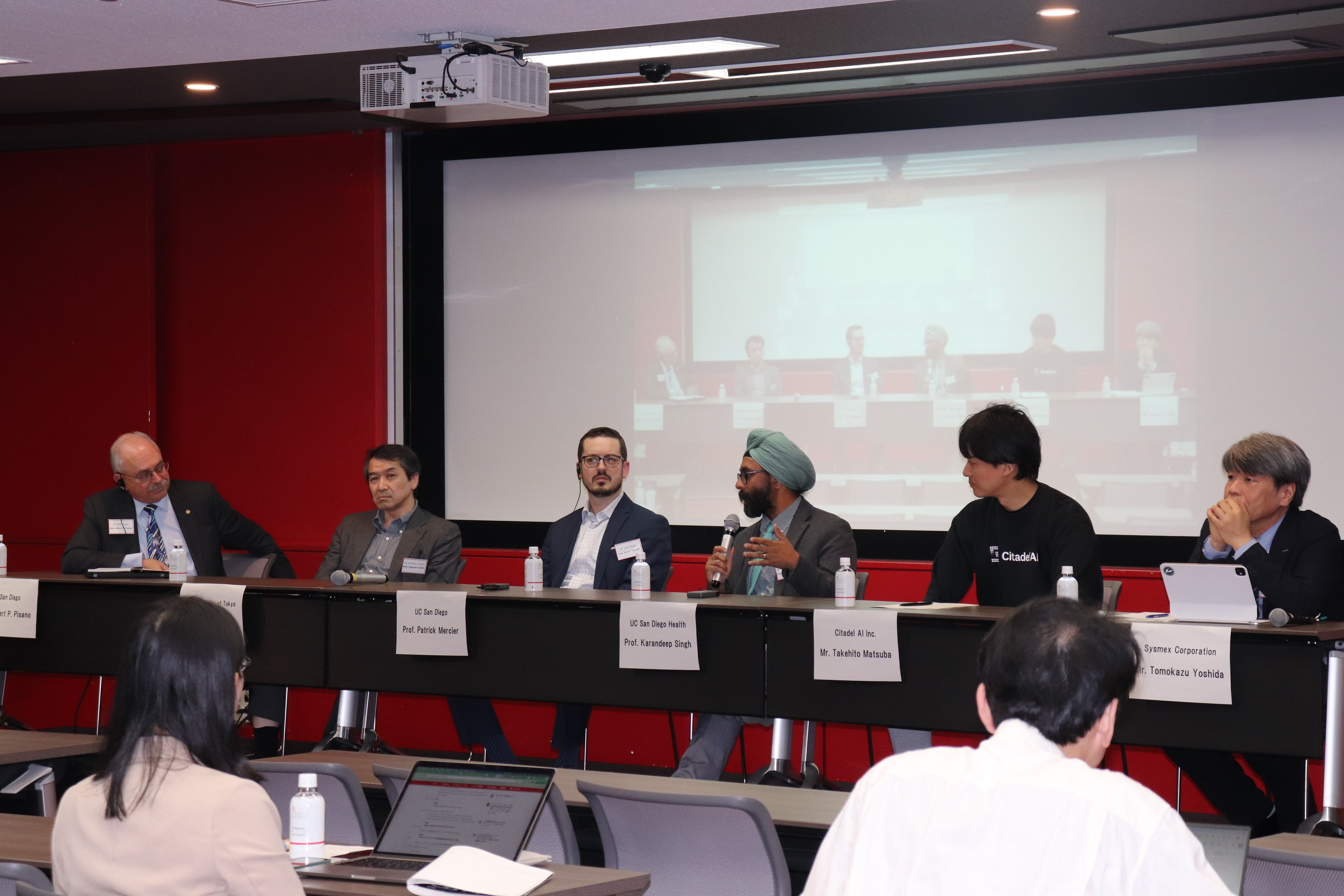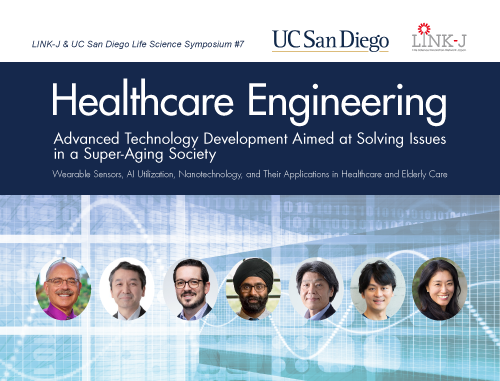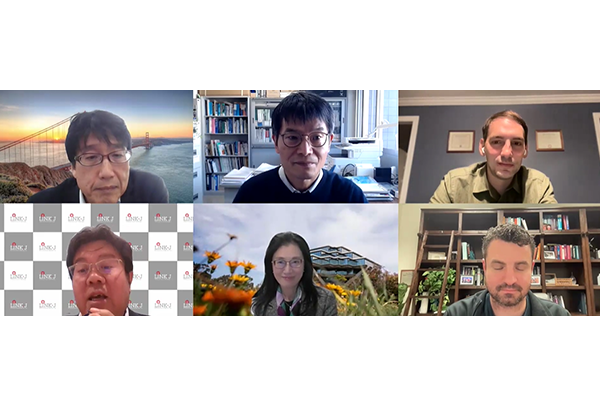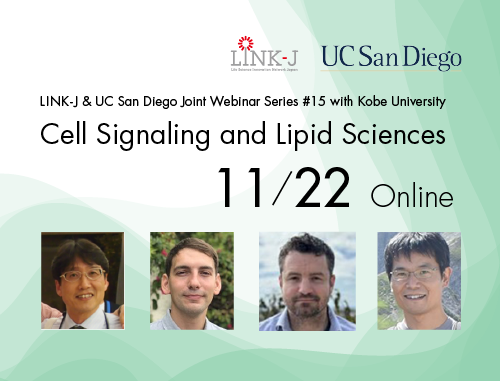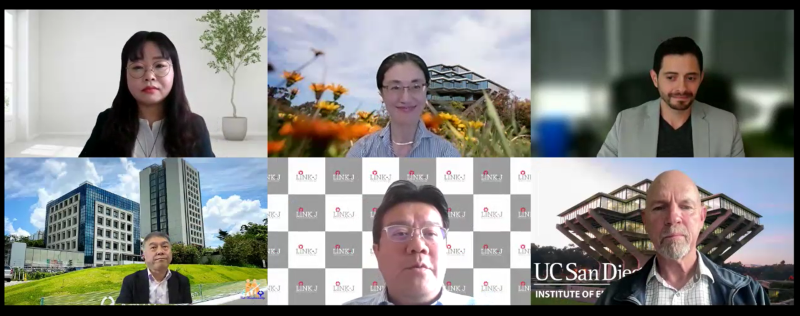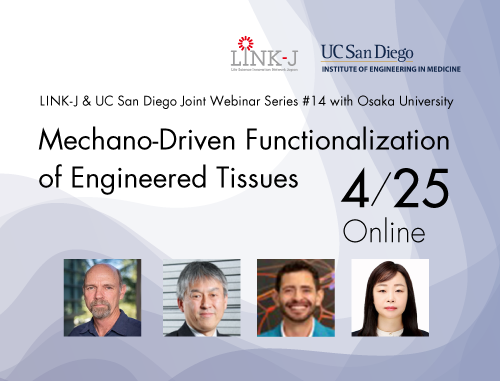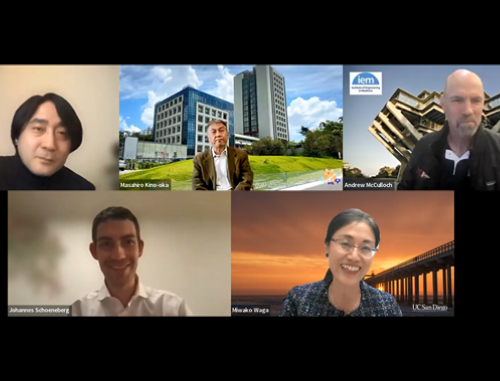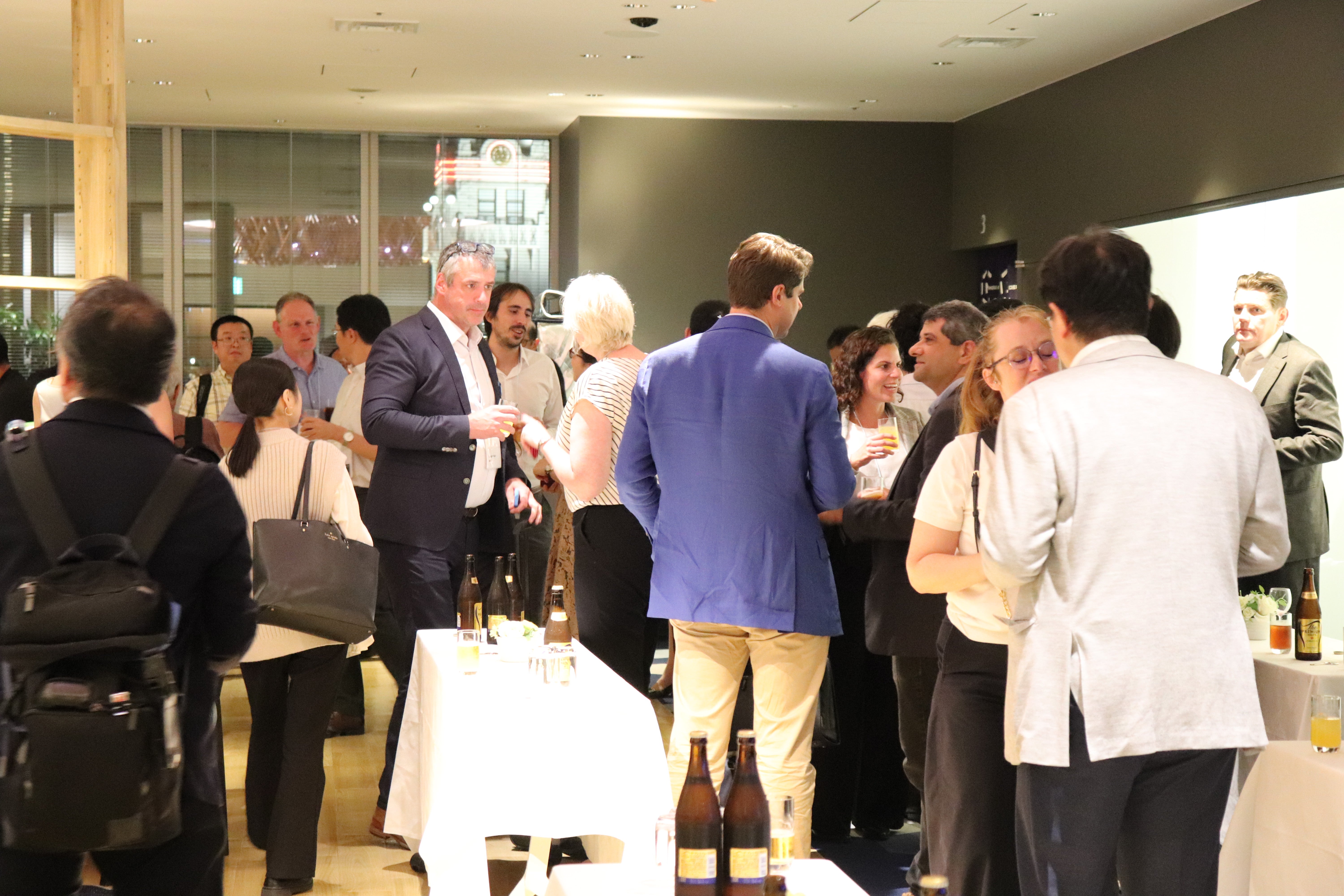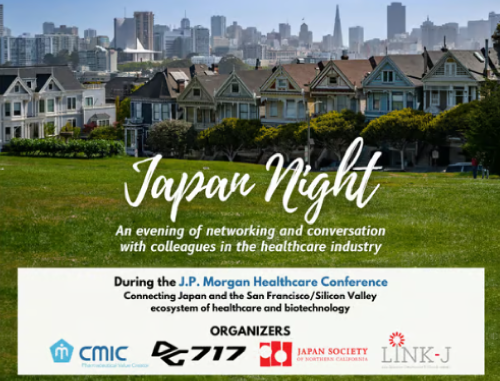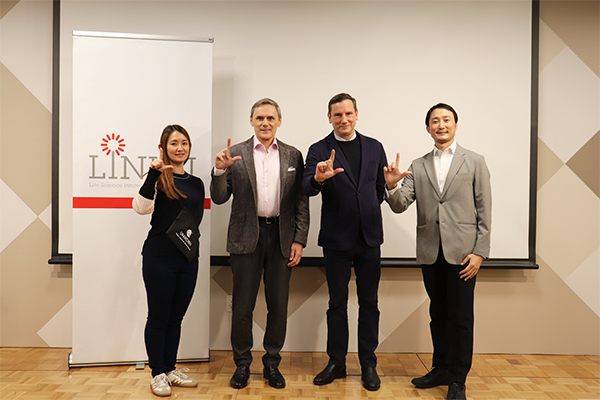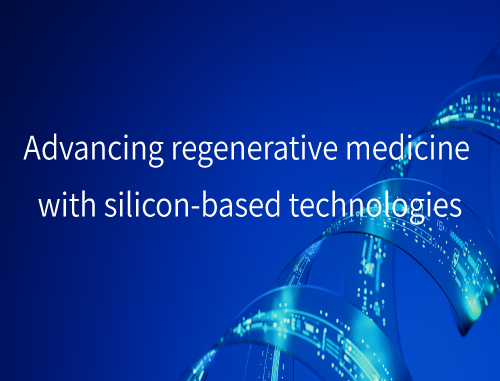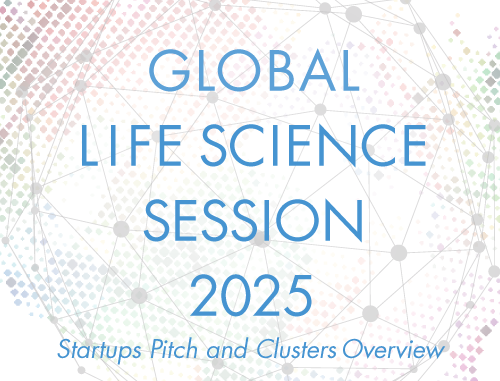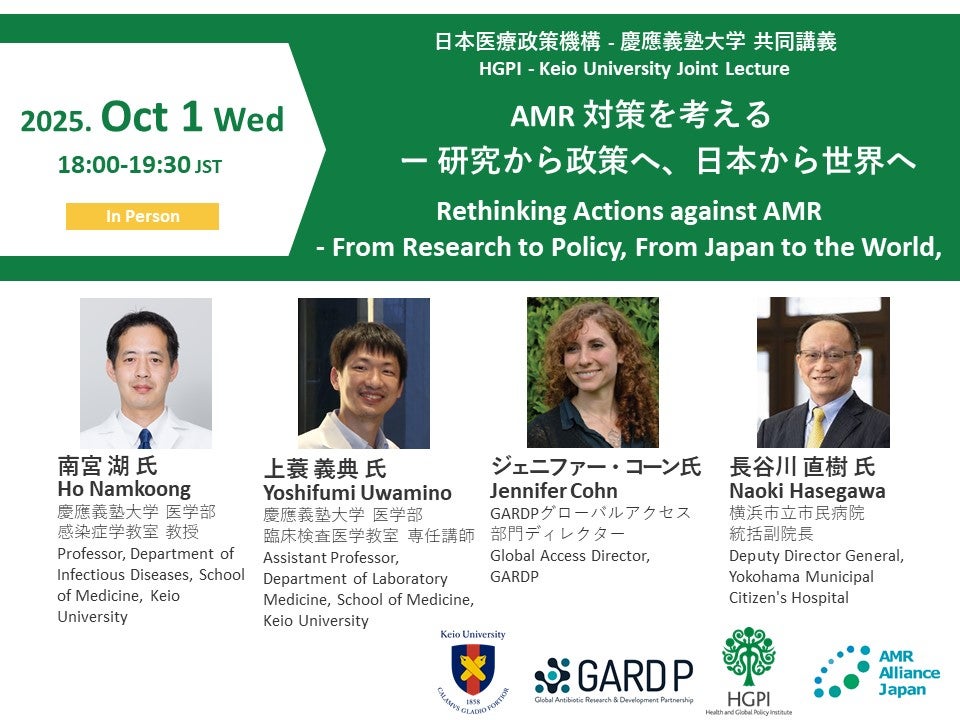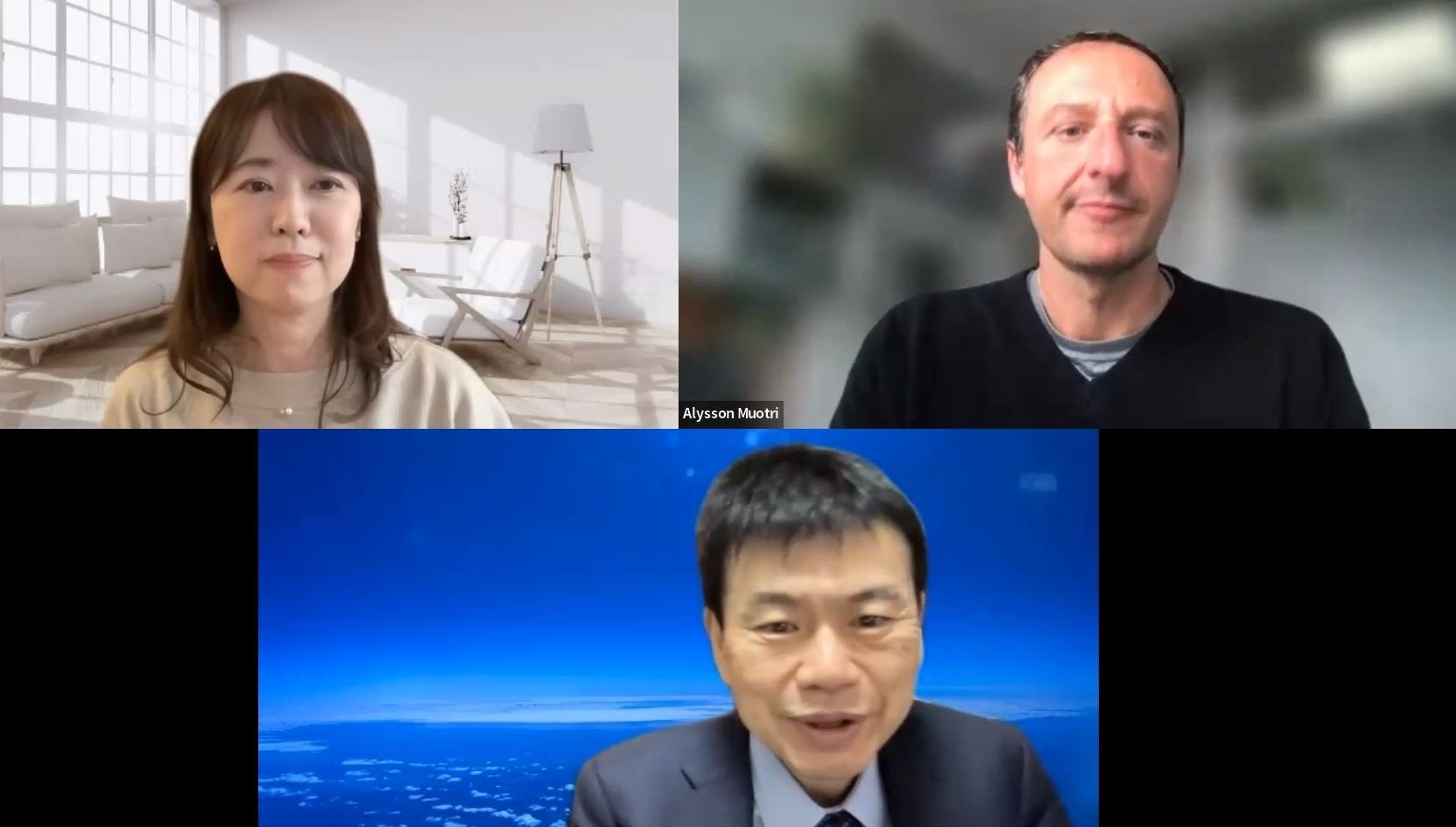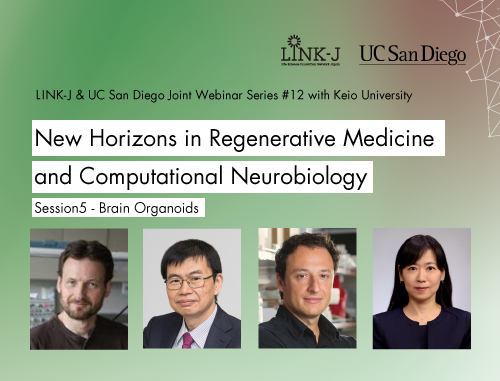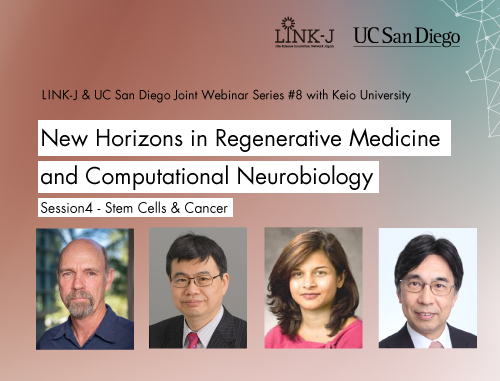LINK-J and UC San Diego co-hosted the "Joint Webinar Series #1 - #5" on December 18, 2020, January 15 & 29, and February 5 & 10, 2021. (Host: LINK-J, Co-Host: UC San Diego)
LINK-J and UC San Diego had collaborated over the years, with distinguished UC San Diego researchers invited to speak at special symposiums in Japan. In light of the impact of COVID-19, this year we shifted to joint webinars featuring top researchers from Japanese universities and UC San Diego. This report summarizes each of the sessions.
The recordings of the webinars are available from the link below.
https://www.youtube.com/c/LINKJ
Please note that some content is unavailable, and that the webinars might be deleted from the archive in the future. We encourage you to subscribe to LINK-J's YouTube channel to view great content.
Joint Webinar #1 with Kyoto University - "Front-Line Nano-Engineering and Drug Delivery Technologies" (December 18, 2020)
We invited Dr. Nicole F. Steinmetz from UC San Diego and Dr. Yasuhiko Tabata from Kyoto University to give lectures on the latest trends in nanoengineering and drug delivery technologies.

"NanoEngineering Gone Viral: Plant Virus-Based Immunotherapy and Vaccines"
Dr. Nicole F. Steinmetz (Professor, Department of NanoEngineering and Director, Center for Nano-ImmunoEngineering (nanoIE), Jacobs School of Engineering, UC San Diego)
Nanoscale engineering is revolutionizing the way we detect, prevent and treat diseases. Viruses are playing a special role in these developments because they can function as prefabricated nanoparticles. We utilize and build-upon the high-precision assemblies of the viral capsids and utilize them as platform technologies, engineered and repurposed for a desired function. More specifically, we turned toward the engineering of plant viruses as a platform nanotechnology. Plant viruses are non-infectious toward mammals. A particular advantage of plant virus-based technologies is their manufacturing and engineerability; genetic programming enables in-planta production of pre-functionalized nanoparticles with a high degree of quality control and assurance. Plant virus-based technologies could be produced 'in the region for the region' in developing countries lacking a conventional refrigeration system and health infrastructure, toward low-cost and edible therapeutics. Opportunity exists to incorporate these materials into devices to produce designer therapeutics that do not require a cold chain for storage or distribution. We have developed a library of plant virus-based nanoparticles and through structure-function studies we are beginning to understand how to tailor these materials appropriately for applications targeting human, veterinary and plant health. Through chemical biology, we have developed virus-based delivery systems carrying medically-relevant cargo enabling tissue-specific imaging and treatment. A particular exciting avenue is the development of plant virus-like particle platforms for cancer immunotherapy. The idea pursued is an 'in situ vaccination' to stimulate local and systemic anti-tumor immune responses to treat established disease, and most importantly to induce immune memory to protect patients from outgrowth of metastasis and recurrence of the disease. Another avenue is the repurposing of plant viruses to enable plant health; we employ principles of nanomedicine to target pesticides residing deep in the soil therefore challenging to reach using contemporary pesticides. I will highlight engineering design principles employed to synthesize the next-generation nanotherapeutics using plant virus-based platform technologies, and I will discuss the evaluation of such in preclinical mouse models and canine patients as well as in the agricultural arena.

"Drug Delivery Technologies for Future Advanced Medical Treatment"
Dr. Yasuhiko Tabata (Professor, Laboratory of Biomaterials, Department of Regeneration Science and Engineering, Institute for Frontier Life and Medical Sciences, Kyoto University)
As a future advanced medical treatment, regenerative medicine based on the natural-healing potential of body itself has been recently expected. To this end, it is indispensable to promote the proliferation and differentiation abilities of cells for tissue regeneration which plays a key role in the healing potential. Recent advent of biomaterial technology or methodology enables to give cells a local environment to naturally induce their ability enhancement. When a cell scaffold or a key molecule is efficiently supplied to cells, the body system initiates to physiologically function, resulting in the natural induction of cell-based tissue regeneration. The efficient supply of key molecule is achieved by making use of drug delivery system (DDS) technology. This DDS technology can also improve the in vivo viability and functions of cells, promoting the therapeutic efficacy of cell transplantation.
Biodegradable hydrogels are available for the controlled release of growth factors, chemokines, genes, and low-molecular-weight drugs to succeed in cells activation for regeneration therapy of various tissues. The hydrogel system can not only release one type of drug, but also two types of drugs in different concentrations or time profiles. For example, the controlled release of one drug can enhance the in vivo recruitment of key cells, followed by the local functional activation of cells recruited by another drug released for an enhanced cell-based tissue regeneration. Inflammation is one of the essential host responses to pathologically modify the process of tissue regeneration. Tissue regeneration was naturally promoted by positively regulating the inflammation process through the local release of an anti-inflammatory drug. An appropriate regulation of inflammation further enhanced the therapeutic efficacy of tissue regeneration which is induced by the biomaterial technology.This paper emphasizes the functional activation of cells originally present in the body by utilizing the DDS technology is one of the promising strategies of future advanced medical treatments.
Joint Webinar #2 with Keio University - "New Horizons in Regenerative Medicine and Computational Neurobiology" Session1 Regenerative Medicine" (January 15, 2021)
For the second and third in the joint webinar series, we invited Dr. Andrew McCulloch (Distinguished Professor of Bioengineering and Medicine; Director, Institute of Engineering in Medicine, UC San Diego) from UC San Diego and Dr. Hideyuki Okano (Dean, Graduate School of Medicine, Keio University) from Keio University as moderators to discuss the latest trends in regenerative medicine and computational neurobiology. (Session1: Regenerative Medicine/ Session2: Computational Neurobiology)
In 2015, Keio University and UC San Diego signed a Memorandum of Understanding (MOU) to foster collaboration between both educational institutions in areas of common interest in medicine. In 2020, the MOU was renewed in order to expand the scope of cooperation to include bioengineering, and the theme of this webinar was selected based on that.

"Using stem cells to probe mechanisms of Alzheimer's disease"
Dr. Lawrence S. B. Goldstein (Distinguished Professor, Department of Cellular and Molecular Medicine, Department of Neurosciences, UC San Diego; Scientific Director, Sanford Consortium for Regenerative Medicine)
Alzheimer's disease is progressive and incurable. The disease process is not fully understood yet. The amyloid cascade hypothesis, which has become mainstream in recent years, has its problems, as shown by the fact that many large-scale clinical trials targeting amyloid-β and plaque result in failure. Dr. Goldstein has been using human stem cells in his research in order to deepen the understanding of this disease. His study suggests that a multi-pathway model is appropriate for considering how different genetic and environmental factors lead to changes in amyloidβ and tau proteins, ultimately leading to the loss of synapses and Alzheimer's disease. In addition, a medicine that might be useful for people has been identified. As further progress is made, research on human subjects will be conducted in clinical trials.

"Regenerative medicine for spinal cord injury using iPS cells"
Dr. Masaya Nakamura (Professor & Chair, Department of Orthopaedic Surgery, Keio University School of Medicine)
It was once believed that spinal cord injuries (SCI) result in devastating loss of function because spinal cord of human beings never regenerates after injury. However, recent advances in neuroscience have opened up the possibility of curing patients with SCI. The regeneration of damaged spinal cords involves a variety of factors. This study focused on cell transplantations and details the concept of iPS-NSC transplantation and its underlying mechanisms. iPS-NSC transplantation quickens functional recovery of the spinal cord after injury, and should be for subacute SCI patients to promote functional recovery. However, this is not the case for chronic SCI patients, as cell transplantation alone is not efficient. The study suggests that it is necessary to combine cell transplantation with rehabilitation to enhance functional recovery. A clinical trial of neurological rehabilitation using robotic suits for patients with chronic SCI has already begun, and the lecture was concluded with the expectation that combining these therapies will make recovery from SCI a reality in the near future.
Joint Webinar #3 with Keio University - "New Horizons in Regenerative Medicine and Computational Neurobiology" Session2 Computational Neurobiology" (January 29, 2021)

"How memories are consolidated while you sleep"
Dr. Terrence Sejnowski (Professor and Laboratory Head, Computational Neurobiology Laboratory, Francis Crick Chair, Salk Institute for Biological Studies; Distinguished Professor of Biological Sciences, UC San Diego)
Your brain is active during sleep as it cycles between deep, slow wave sleep and rapid eye movement (REM), or dream sleep.
Evidence is accumulating that messages between the hippocampus and the cortex during these sleep stages sets the stage for the consolidation of long-term memory.
Recordings from human cortex have revealed dynamical patterns of electrical that may instrumental in triggering mechanisms for synaptic plasticity during non-REM sleep.

"Real time KANSEI and Stress Extraction only using Frontal EEG"
Dr. Yasue Mitsukura (Professor, Department of System Design Engineering, Faculty of Science and Technology, Keio University)
We proposed a method to quantify "KANSEI" by acquiring EEG, performing noise removal, analyzing data, and making mathematical model (system identification).
KANSEI is Japanese word because studied at first in Japan. KANSEI is similar to Emotion but different. Emotion is innate ability but KANSEI is acquired after birth along with lifestyle. Although many noises appear on the EEG, we also propose a method to remove them in real time. In addition to KANSEI, we also define stress using EEG. It is very difficult to define KANSEI and stress using EEG, but we successfully defined it using 17 years' worth of data while associating them with hormones.
Joint Webinar #4 with Osaka University Global Center for Medical Engineering and Informatics (MEI Center) - "Mechano-Driven Functionalization of Engineered Tissues" Session1 Mechanobiology and Cell Matrix Interactions" (February 5, 2021)
For the fourth and fifth in the joint webinar series, we invited Dr. Andrew McCulloch from UC San Diego and Dr. Masahiro Kino-oka (Professor, Department of Biotechnology, Graduate School of Engineering, Osaka University) from MEI Center as moderators to discuss the latest trends in mechano-driven functionalization of engineered tissues. (Session1: Mechanobiology and Cell Matrix Interactions/ Session2: Biofabrication)
UC San Diego and Osaka University have a long history of collaborations in education and research. In recent years, they have strived to expand their areas of collaboration to include bioengineering, bioinformatics, tissue engineering, and regenerative medicine.

At the beginning of the webinar, two representatives of each university gave opening remarks.
Dr. Sandra Brown (Vice Chancellor for Research, UC San Diego)
Dr. Haruhiko Kishima (Director, Global Center for Medical Engineering and Informatics, Osaka University)

"Systems engineering approaches to advance understanding of cell-ECM interactions regulating migration"
Dr. Stephanie Fraley (Associate Professor of Bioengineering, Jacobs School of Engineering, UC San Diego)
Understanding how living cells migrate in reliable and orchestrated ways is essential to understanding the most fundamental functions of eukaryotic life and also numerous disease processes. Cell migration is a complex and heterogeneous emergent behavior that arises from the mechanical and chemical interactions of tens of thousands of molecular parts over numerous spatial and temporal scales. This complexity has meant that even now, we have no quantitative understanding of how cells integrate environmental cues and their vast molecular machinery to give rise to reliable whole cell and multi-cell behaviors.
My lab's central hypothesis is that emergent cell migration behavior is generalizable, predictable, and controllable through the application of a multi-scale systems engineering approach. In this talk, I will highlight three of our studies where we have developed technical and conceptual advances towards achieving this goal. The first describes our advancement of quantitative microscopy approaches to enable the simultaneous measurement key cell-extracellular matrix interactions underlying cell migration to enable data-driven modeling. The second presents a method to physically sort cells based on migration phenotype for single-cell sequencing and gene regulatory network analysis. The third showcases our development of a transfer function by which substrate stiffness is converted into mechanotransduction outcomes and is capable of accounting for seemingly contradictory experimental trends.

"Machine learning-based detection of cellular traction forces"
Dr. Shinji Deguchi (Professor, Mechanical Science and Bioengineering, Graduate School of Engineering Science, Osaka University)
Recent progress in understanding the essential roles of mechanical forces in regulating various cellular functions expands the field of cell biology to one where interdisciplinary approaches, in addition to conventional molecular biology approaches, become indispensable. Cellular traction forces (CTF) - typically present in proliferative cells including cancer cells - are one of such mechanical forces that regulate the function of the cells, and thus the measurement of the forces using engineering techniques is becoming a key for better understanding of the complicated phenomena. CTF is created with the activity of ubiquitous proteins known as nonmuscle myosin II and actin, but because these proteins work downstream of diverse signaling pathways, it is often difficult to predict how the CTF may change upon perturbations to particular molecules such as gene mutations and drugs. Here I will talk about our new technology with a high-throughput data analysis capability to determine whether the CTF is upregulated or downregulated upon perturbations. For this experiment, we plate cells on deformable substrates, in which "wrinkles" are generated on the surface upon the exertion of CTF. These wrinkles are detected and finally converted to the magnitude of a physical force by using a machine learning technique. This technology allows us to comprehensively evaluate the change in cell function/disease-associated CTF caused by perturbations to particular genes and how those changes are enhanced or rescued by means of drugs.
Joint Webinar #5 with Osaka University Global Center for Medical Engineering and Informatics (MEI Center) - "Mechano-Driven Functionalization of Engineered Tissues" Session2 Biofabrication" (February 10, 2021)

"Rapid 3D Bioprinting for Precision Tissue Engineering"
Dr. Shaochen Chen (Professor and Chair, NanoEngineering, Jacobs School of Engineering, UC San Diego)
This session featured Rapid 3D bioprinting that can be used for precision tissue engineering. Dr. Chen is the Founder and a Scientific Advisor of a startup (Allegro 3D, Inc.) that commercializes bioinks, bioprinters, and bioprinted tissues. The company's mission is to use 3D bioprinting for the repairing and regeneration of damaged internal organs as well as drug screening. The new 3D bioprinting system that was presented is extremely fast and precise. With the specifications listed below, it can produce tissue scaffolds and biological tissue models.
- 3D micro-structures (shapes, porosity)
- Mechanical property (e.g. stiffness, Poisson ratio)
- ECM composition
- Cell placement (multi-cellular architecture)
3D bioprinting is a transformative technology for precision tissue engineering, and less costly and less time-consuming than conventional methods. It can also use human models instead of 2D or animal ones.

"Biofabrication for 3D-Human Tissue Models by Nano/Micro-Biomaterials"
Dr. Michiya Matsusaki (Professor, Applied Chemistry, Graduate School of Engineering, Osaka University)
The webinar also featured a lecture on the biofabrication of 3D-human tissue models by nano/micro biomaterial.
The topic was that creating 3D-human complex tissue models which can be applied to high-throughput screening systems, and proposed two ways of creating such models. These could have practical applications in pharmaceutical and drug discovery research. The aforementioned two ways include nano-coatings, which are useful for stimulating cell-cell interaction and creating layered structures, as well as the creation of hard tissue models with high-density ECM using collagen microfibers.

In this webinar series, each session included time for Q&A and panel discussion, which led to interesting interactions with the audience.
Thank you very much for your active participation in the joint webinars. We plan to offer similar sessions in the future. Stay tuned!
